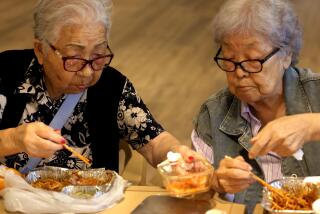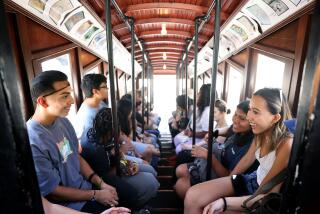High Life : A WEEKLY FORUM FOR HIGH SCHOOL STUDENTS : A 6-foot-3 Senior Finds He Can Fit In During Stay in Japan
One hundred American students, 100 Japanese families and one summer. What do you get when you put them all together?
A summer full of sushi, Kabuki, Mt. Fuji . . . and humanity.
This summer I experienced all of this as part of the Youth for Understanding Japan-U.S. Senate Exchange, a joint project of the U.S. and Japanese governments.
Straight out of Southern California, I was taken, along with 99 students representing every state in the nation, by way of a Washington orientation, to Japan, where I spent two months living with a family in Tokyo.
While in Tokyo, I was allowed to live life as a citizen rather than as a tourist. Foreigners often see only the shrines and temples, which are but a small part of the real Japan.
The people I met there, the friends I made, and the generosity of my host family were more memorable than any of the country’s beautiful architecture.
Along with the other U.S. students, I wondered if we ever would be accepted in Japan with a culture so different from our own.
To a great extent, the people who presented our orientation in Washington laid to rest many apprehensions. But there remained plenty of questions that would just have to go unanswered until we arrived in Japan.
As quickly as we had been thrown together, we arrived in Tokyo, and it was time to go our separate ways. After a hectic day of touring the city, we met our host families.
A Japanese lady, apparently recognizing me from my application photo, introduced herself in English as my host mother, Yuriko Suzuki. I introduced myself in Japanese as her exchange student, but it turned out she spoke English fluently.
This was a relief, since my introduction represented about 20% of the Japanese I had learned while in Washington.
After stopping at the offices of the Asahi Shimbun, one of Japan’s largest newspapers, to visit my host father, Satoshi Suzuki, who works there, my host mother and I went home by way of the Tokyo expressways. Having this experience, I will never again be frustrated by Orange County’s traffic conditions.
After winding through a confusing maze of incredibly narrow side streets and alleys, we arrived at our destination--Setagaya Ward, a suburb of Tokyo.
Arriving at the Suzukis’ house, we were greeted by my host mother’s parents, the Kojimas, and my host brother, Tsuyoshi, and his friend, Fumito Kitamura.
After a traditional Japanese dinner and some conversation, I went to bed in the room I would share for the summer with Tsuyoshi.
The first “culture shock” I received was discovering that Japan is not a country designed for people who are 6-foot-3. That did not change the fact, however, that I was three inches taller than the 6-foot doorways in my host family’s home.
Once I had finally recovered from jet lag and had begun to get to know the people of Japan, the thing that struck me more than anything else was their hospitality and generosity.
Friends and relatives of my host family, as well as total strangers, willingly gave of their time and selves to make sure my stay was as pleasant as possible.
More than once I found that my casual reference to some place of interest in Tokyo was met by offers to take me there and serve as my guide.
After I had traveled a bit in Tokyo, I was able to ride the trains alone. So, armed with my English-Japanese dictionary and having the phrase “Where is . . . ?” down pat in Japanese, I ventured into the city.
The only problem using this phrase was that I had used it so often, I fooled people into believing I spoke their language.
So, rather than being met by a slow response and lots of hand signals, I often received lightning-fast answers, which were thorough but completely incomprehensible to me.
I merely tried to pick out the first direction I had heard--either left or right--and head that way in hopes of finding someone else to ask.
More than once, Tokyoites went far out of their way to escort me to my destination. Unfortunately, I was never able to return the favor as I was hardly a prime candidate for someone to ask directions.
But as my host mother pointed out, this was actually a mistake, since I rarely set foot outside the house without four or five maps covering the trains, subways, geography and sights of Tokyo.
On occasion I made short trips out of Tokyo with my host family. The most exciting was when my host parents, brother and I took the “Bullet Train” to Kyoto--a 600-mile trip that took only three hours.
Kyoto is my host father’s birthplace, and it was with great care and pride that he showed me the city’s beautiful temples and shrines.
One temple, the Golden Pavilion, is actually covered in a layer of pure gold.
On another occasion, I was convinced by some other Americans in Tokyo to do something “really Japanese.”
Late at night, in the company of several hundred tourists and religious pilgrims, we began an ascent of 12,388-foot Mt. Fuji. The idea was to climb through the night and watch the sunrise from the summit. But by the time we were halfway up, we encountered strong winds and rain.
We persevered in search of the perfect sunrise, but at the top we were greeted by more rain and finally a sunrise that was filtered by the cloud-filled sky.
Disappointed as we were, the experience left us with vivid memories and great souvenirs--walking sticks emblazoned with the mountain’s name and elevation.
This past summer in Japan proved to be the best I’ve ever experienced. My host family, my friends and teachers at Keio High School in Tokyo and all of the people I encountered through my travels helped to make it a trip I will not soon forget.
If you are interested in a presentation about the program, contact Shanker at (714) 720-0348 or 1815 Port Manleigh Place, Newport Beach, Calif. 92660
More to Read
Sign up for Essential California
The most important California stories and recommendations in your inbox every morning.
You may occasionally receive promotional content from the Los Angeles Times.










